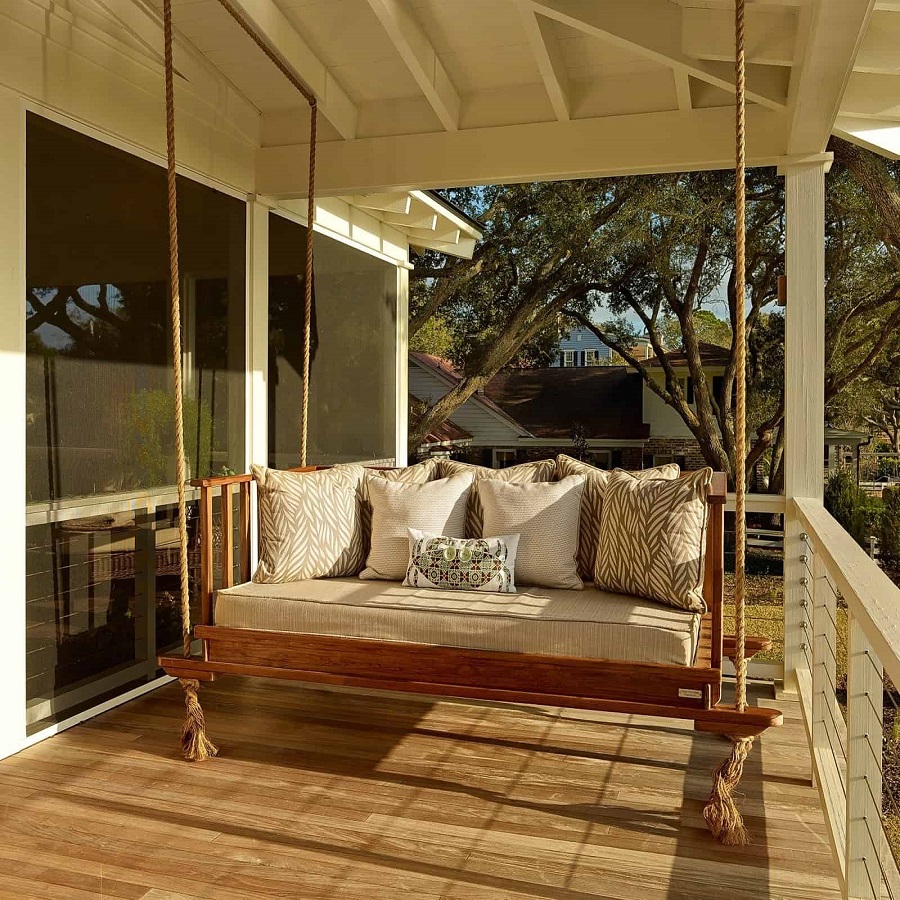Creating a porch swing is a rewarding project that can enhance the beauty and comfort of your outdoor space. This comprehensive DIY tutorial will guide you through the process step by step, ensuring you have all the information you need to build a sturdy and beautiful porch swing. Let’s dive into the materials, tools, and techniques necessary for this delightful project.
Understanding the Basics of Porch Swings
What is a Porch Swing?
A porch swing is a suspended seat that adds charm and relaxation to any porch or outdoor area. Typically made from wood, porch swings can be painted or stained to match your home’s decor. They come in various designs, from simple and rustic to elaborate and decorative, allowing you to choose one that fits your style.
Benefits of Having a Porch Swing
Porch swings offer numerous benefits. They provide a cozy space for relaxation, allowing you to enjoy the outdoors while staying comfortable. Swings are perfect for reading, chatting with friends, or simply enjoying a cup of coffee. Moreover, a well-built porch swing can increase your home’s aesthetic appeal and potentially boost its value.

Planning Your Porch Swing
Choosing the Right Design
Before you start building, it’s essential to decide on the swing’s design. Consider factors such as size, style, and functionality. Traditional swings are typically flat, while modern designs might include contoured seats for added comfort. Make sure the design fits the dimensions of your porch and complements your home’s architecture.
Gathering Inspiration
Look for inspiration from various sources. Websites like Pinterest and home improvement blogs showcase countless swing designs. Additionally, visiting local home and garden shows can give you firsthand experience with different styles. Take notes and collect images that resonate with your vision for your porch swing.
Materials You’ll Need
Selecting the Right Wood
The most common materials for porch swings include hardwoods like cedar, oak, and teak due to their durability and resistance to weather. Cedar is particularly popular for its natural resistance to rot and insects. Ensure the wood you choose is untreated and suitable for outdoor use, as this will prolong the life of your swing.
Additional Materials and Supplies
In addition to wood, you’ll need several other materials, including screws, wood glue, and outdoor-grade paint or stain. Don’t forget the hanging hardware, such as heavy-duty chains or ropes, designed to support the swing’s weight. A thorough checklist will help you avoid any mid-project runs to the hardware store.
Tools Required for Construction
Essential Hand Tools
Basic hand tools are crucial for building your porch swing. You’ll need a saw (circular or miter), a drill, a screwdriver, a measuring tape, and a square. A sander or sandpaper is necessary for smoothing edges and surfaces. These tools will enable you to cut, assemble, and finish your swing effectively.
Power Tools for Efficiency
While hand tools are essential, power tools can make the construction process faster and more efficient. A power saw will cut through wood more quickly, and a power drill can speed up the assembly process. If you’re familiar with power tools, they can significantly reduce your labor time and improve precision.

Preparing the Workspace
Selecting a Suitable Location
Choose a well-ventilated and spacious area for your project. A garage or a covered outdoor space can protect you from the elements while allowing you to work comfortably. Ensure your workspace is organized, with all tools and materials within easy reach to streamline the construction process.
Ensuring Safety Measures
Safety should be your top priority during any DIY project. Always wear protective gear, including safety glasses and gloves, when using tools. Keep your workspace clean and free of clutter to prevent accidents. Familiarize yourself with the operation of any power tools you’ll be using to minimize risks.
Cutting the Wood Pieces
Measuring and Marking
Accurate measurements are crucial for a well-built swing. Begin by measuring the dimensions of your swing according to your chosen design. Use a measuring tape and square to mark your cuts clearly on the wood. Double-check your measurements before proceeding to cut to avoid wasting materials.
Making the Cuts
Once you’ve marked the wood, it’s time to make your cuts. Use a circular saw or miter saw for straight cuts, ensuring you follow your marked lines closely. Take your time, and remember that precision is key. After cutting, sand down the edges to eliminate any rough spots that could cause splinters.
Assembling the Swing Frame
Building the Seat Frame
Start by assembling the seat frame, which consists of two side rails and two front and back rails. Secure these pieces together using screws or wood glue for added stability. Ensure the frame is square by measuring the diagonals; they should be equal. This step is essential for a balanced and sturdy swing.
Creating the Backrest
Next, you’ll need to construct the backrest. The backrest can be a single piece of wood or several slats, depending on your design. Attach the backrest to the seat frame using screws, ensuring it is at a comfortable angle for leaning back. Check that everything is secure and aligned before moving on.
Finishing Touches: Sanding and Painting
Sanding the Swing
Before applying any finish, thoroughly sand the entire swing. Start with a coarse grit sandpaper and progress to a finer grit to achieve a smooth surface. Pay special attention to edges and corners to ensure they are rounded and safe. This step is critical for comfort and preventing injuries.
Painting or Staining
Choose an outdoor-grade paint or stain to protect your swing from the elements. If you prefer a natural look, opt for a stain that enhances the wood’s grain. Apply the finish evenly using a brush or sprayer, and allow it to dry completely. Depending on the product, you may need to apply multiple coats for optimal durability.

Installing the Swing
Choosing the Right Location
When it comes to installing your swing, selecting the right location is essential. Look for a sturdy overhead structure, such as a porch beam or tree branch, that can support the swing’s weight. Ensure the swing will have ample clearance from the ground and surrounding obstacles for safety and comfort.
Attaching the Swing
Using heavy-duty chains or ropes, carefully attach the swing to your chosen overhead support. Ensure the swing is level by measuring the height from the ground at both ends. Adjust as necessary to achieve a comfortable seating height. Test the swing by applying pressure to ensure it’s securely installed.
Maintaining Your Porch Swing
Regular Cleaning
To keep your porch swing looking its best, regular cleaning is essential. Wipe down the swing with a damp cloth to remove dirt and debris. For deeper cleaning, use mild soap and water, but avoid harsh chemicals that could damage the finish. Regular maintenance will extend the life of your swing.
Seasonal Care
Depending on your climate, you may need to take additional steps to protect your swing during extreme weather. In areas with harsh winters, consider covering your swing or bringing it indoors. For swings left outdoors, reapply paint or stain every couple of years to maintain protection against the elements.
Enjoying Your New Porch Swing
Creating a Cozy Space
Once your porch swing is complete, it’s time to enjoy it! Consider adding cushions and throw pillows to enhance comfort. Outdoor fabric is recommended to withstand weather conditions. You can also decorate the surrounding area with potted plants or string lights for a cozy ambiance.
Gathering with Friends and Family
A porch swing is a fantastic place to gather with friends and family. Host small get-togethers or quiet evenings, using your swing as the centerpiece of your outdoor space. Enjoy the simplicity and tranquility that comes with swinging while engaging in conversation or enjoying a good book.
Conclusion
Building a porch swing is not only a practical DIY project but also a chance to create a beautiful and functional addition to your home. By following this comprehensive tutorial, you can enjoy the satisfaction of crafting a swing that reflects your style and enhances your outdoor living experience. Happy swinging!
